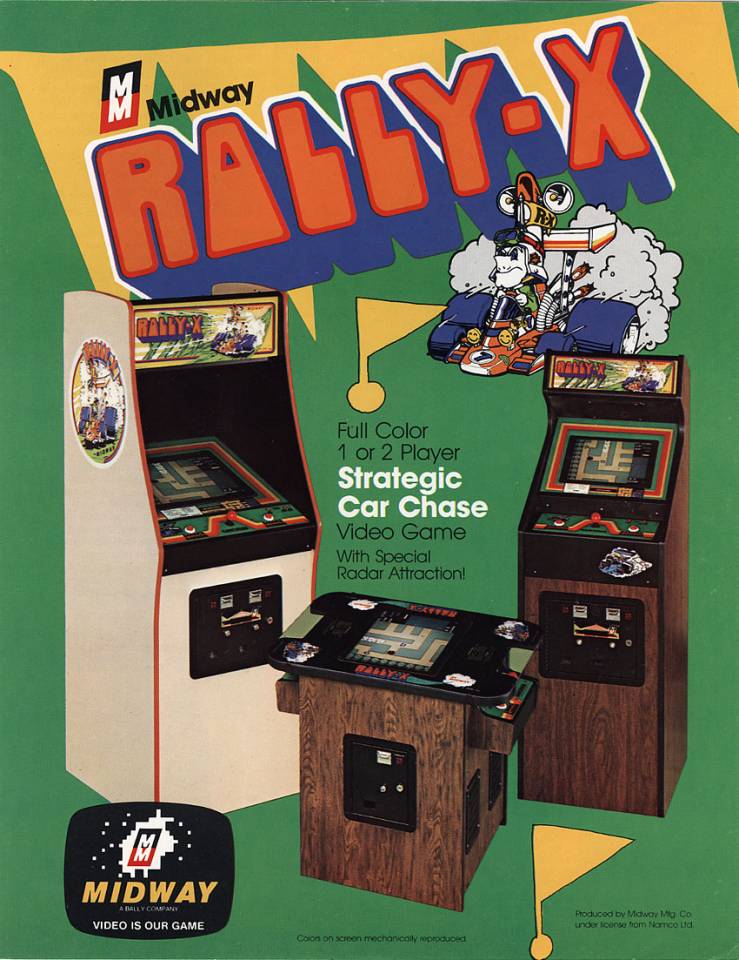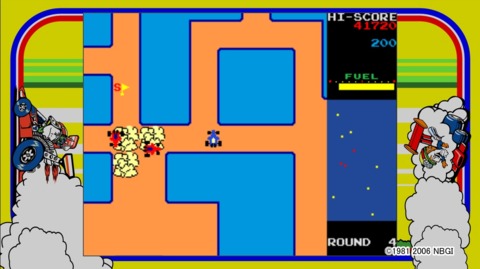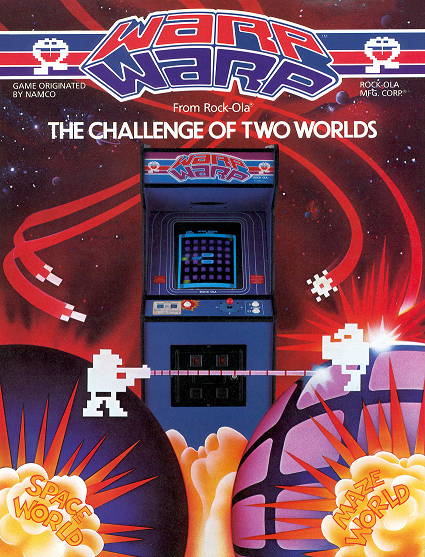NamCompendium is an attempt to survey the output of NAMCO from October 1978 to present. The primary goal of this work is to provide as authoritative of information as possible for Giant Bomb’s Wiki, with the secondary goal of considering the relative merits of individual games. In this entry, we shall consider Namco's immediate followups to their single best known work. Spoilers: they aren't as well known.
We're now three titles away from the next real megaton release from Namco, and goddamn do I dislike two of them. Let's do it do it!
Rally-X
In Rally-X, the player is tasked with navigating a sprawling maze, more or less blind, with the goal of retrieving ten yellow pennants before dying or running out of time. Death may issue from one of two sources: randomly seeded red stones sprinkled throughout the maze itself, and a fleet of cars that work to pursue you in the maze. These cars are marginally faster than the player, meaning it is crucial to prevent these murder cars from getting on their tail. These opponents make the Pac-Man ghosts seem positively charitable, in my experience. If you can avoid them long enough to gather ten flags, the player will advance a level. Three lives and slap another quarter in the cabinet, you know the drill.
So what makes this thing really fall apart? Recall in NamCompendium 4 when I described my main gripe with portable Pac-Man ports being the second "zoomed-in" perspective of the mazes? You know, the one that only reveals a fraction of the play field and obscures both the objectives (dots) and obstacles (ghosts) that the game must surface to the player for the underlying mechanics of the game to work in the first place? Well, that's just how Rally-X works. It's actually worse, in fact. Whereas you can more or less learn and memorize the fairly small mazes of Pac-Man and count on Power Pellets and tunnels being in or around a given location, Rally-X scoffs at these sorts of inner consistencies and pisses its various pickups and obstacles around the maze, then makes the maze itself a mess of blind alleys and cul-de-sacs to nowhere. When you add this restrictive view point, randomly placed obstacles, and vicious opposition cars together, you've already got a punitive game. Now add in that your car's general pace is fast enough to make responding to rocks in your path a challenge, and the fact that you are given a hard time limit per level in the form of finite fuel for your vehicle, and the game basically stands on your ballsack while you play it.

The perspective was enough of a problem that one of the staff assigned to the project to create a solution, something that represents one of the NamCompendium Firsts: this is the first Namco game with a minimap. It's a bad one, but it is there. The minimap in this game takes the form of an empty rectangle that eats about the entire bottom right sixth of the screen, and considering the amount of real estate it occupies you really have to wonder why they bothered. Yes, it does show your relative position in the maze. Yes, it does show the locations of the pennants (including the Special Flags, which fans of Super Smash Brothers will recognize). And yes, it even deigns to reveal the positions of the opposition's cars... in real-time, even! So what's the issue? Simply, it doesn't bother to display the actual maze layout or the positions of the rocks. The latter I could perhaps forgive, as having to learn one obstacle by fumbling around would only be a large pain in the ass. Instead, as they omit providing you the maze layout in whole, the game just feels like you fumble around waiting to accidentally kill yourself or get run the hell over by enemies. The only interesting decision in this game is your defensive tactic: you are able to spray a cloud behind your vehicle that causes your pursuant to spin out, but at the expense of your finite fuel supply. It's an idea, but I don't think it elevates the game out of the crater in which it exists. The core loop remains the same: scan the minimap for the closest flag, navigate a blind maze on your way there, and hope you don't die along the way.
There's another NamCompendium First here that's worth discussing: Rally-X is the first Namco title with full background music. Gee Bee, their first title had basic sound effects; SOS featured a brief four note phrase during its fan service rewards, Galaxian had sound throughout the gameplay, and Pac-Man introduced (arguably) video game music's first great sample. But Rally-X has music throughout, a first for the company. Unfortunately, it is not completely clear who composed it. Wikipedia has Ohnogi Nobuyuki as the composer, while StrategyWiki and Moby Games (a source that was good enough for this website, or so I've heard) has Toshio Kai as the man behind the tunes. I'm going to err on the side of the latter in building out the Wiki, but am open to being corrected. Kai's previous contributions to video game music on Pac-Man are infinitely better known, and for good reason. The music is an incredibly short, repetitive, muddy loop that fails to charm or excite the player a fraction as much as a brief jingle does at the start of a level of Pac-Man. There is a similar jingle at the start of a game of Rally-X, but I'd only characterize it as "fine".
Rally-X was also the first Namco title to introduce bonus rounds, or CHALLENGING STAGE levels at intervals. Here you are tasked with collecting all the flags in the third (and every four levels after the third) level without the constant harassment from enemy cars. There's still the crummy map, rocks, and finite fuel to help stymie your efforts, however, and it's still more Rally-X.
Rally-X made it to a handful of microcomputers over the years, but Namco has not put a lot of effort into dragging this game out of the closet over the years. It was ported to the PlayStation alongside Pac-Man onto Namco Museum Volume 1 in 1995, and included in the 1996 arcade compilation release titled Namco Classic Collection Volume 2. NCCv2 is an odd duck as it included remixes of Pac-Man, Dig Dug and Rally-X. These "arrangement" versions of the games were well received at the time, and have since found their way onto the Game Boy Advance (Pac-Man Collection, 2001 [just Pac-Man Arrangement here]), PS2, Xbox, and GameCube (Namco Museum, 2001). Even here, though, Rally-X went relatively unloved as it was the only one of these Arrangements to not receive a 2-player mode.
From there, Rally-X has made appearances in a sampling of Namco Museum compilations:
- Namco Museum Battle Collection (PSP, 2005)
- Namco Museum 50th Anniversary (PS2, XBOX, GCN, 2005)
- Namco Museum Virtual Arcade (360, 2008)
- Namco Museum Megamix (WII, 2010)
To the best of my knowledge, Rally-X is the sole work in the video game industry of one Ito Hirohito. His name does not appear on any other Namco titles that I have found thus far in my digging, or really anywhere else on the English speaking Internet. His legacy is, in my estimation, a deeply flawed arcade entry. It did spawn the two aforementioned Namco Firsts, however, in addition to a third we shall now discuss.
New Rally-X
There are a few instances I have found throughout the long and storied history of Namco where, for reasons we shall be exploring on a case by case basis, the company decided to have another crack at a game and release an updated version. The first such case of this phenomenon was with Rally-X, which received an up/sidegraded release a paltry two months after its natural birth.
This time, the project was handled by none other than Yokoyama Shigeru. Yokoyama-san had done design work on Cutie Q, Navarone, and King & Balloon by this point, and was about to forge his masterpiece later in 1981. But for now, he took the reigns of the team that had produced Rally-X the first and sought to rework the game into something a little less fart-flavored.
It didn't work, really. Rather than a full reconsideration from the ground up, Yokoyama's vision was more of a rebalancing of the game than a reenvisioning. The number of enemy cars starts fewer, and steadily scales up per each non-bonus levels. In addition to the S-Flag, there is now an additional Lucky Flag (marked on the map) which provides bonus points based on the amount of fuel the player has left. The S-Flag's location is provided on the minimap, which is handy for pursuing high scores. They even lowered the threshold for extra lives, down from 100,000 to 80,000 for the second additional player car. Finally, the background music is a much improved loop by (to the best of my knowledge) Ohnogi Nobuyuki. It's not SMB1 Overworld, but having a nifty little bass line does help worm the track into your brain.
Alas, these tweeks were layered atop the same rickety skeleton of its successor. Rally-X with some balance adjustments is still a game about fumbling through a maze while avoiding pursuing cars and rocks until you collect the requisite flags to advance. Even with some changes to the color pallette between this and the original release, I find the very act of looking at the Rally-X maze to be distasteful. It's all a lot of garish pinks and fake vomit oranges, and I've even devised a game for you based on the visuals of these games. I want you to try to envision Pac-Man. See how long that took your brain? Instantaneous. Now, I want you to envision your car from Rally-X. You can't. It is non-descript to a degree that I could show you any pixel art car and you may believe me.
It is this updated take on the Rally-X formula that has really made the rounds. First compiled alongside Rally-X in the aforementioned Namco Museum Volume 1 (which is a bit like packing two different types of Tootsie Rolls into a pouch of licorice all sorts), New Rally-X's next appearance came as the loading screen game for Ridge Racers, a PSP launch title in Japan. There's even an unlockable Rally-X car in the game, obtained by reaching a high enough score in New Rally-X. Now that's cruel! Next came an appearance in the Japan-only Namco Museum, a 2005 PSP compilation that was itself repackaged with additional titles in the west as Namco Museum: Battle Collection. Said collection includes a unique remixed version of the game, "New Rally-X Arrangement", that as far as I can see has not appeared elsewhere.

New Rally-X is most easily played today in its Xbox Live Arcade form, which was released in 2008 and is included in Namco Museum: Virtual Arcade. This one installs directly to the hard disk, and unlike King & Balloon from NamCompendium 5 you can obtain achievements to prove your devotion to the Rally-X lifestyle. The game's most recent compilation appearance came in 2010, when it was crammed into Namco Museum Megamix for the Wii.
There are some extraordinarily generous people on the World Wide Web who have described Rally-X and New Rally-X as prototypical open world games, even citing them as direct influences on top down open world vehicular based games like the original Grand Theft Auto. That seems completely insane to me, but then again I believe I have made my feelings on these games quite clear. I dislike Rally-X on a deep, fundamental level. Moving right the hell on then.
Warp & Warp
We bid farewell to Namco's first internally developed arcade board, built around the venerable Intel 8080 processor*, with Warp & Warp. Planned by Okamoto Shinichiro, whose prior work was the not-so-hot Tank Battalion, Warp & Warp is as baroque as the former is plain. The game plays like a strange progenitor to Bomberman combined with Nintendo's Sheriff, but set in space. With teleportation! It's crazy!
Play begins in what I'll call the "Sheriff" phase for the sake of this article. The player is placed in a square playfield and tasked with shooting a number of aliens called Berobero. These aliens issue from the four corners of the arena, and remind me of Cutie Q's baddies in their general design. These aliens walk in straight counter-clockwise lines, gradually working their way toward the center of the playfield. This field is invisibly divided into "rings" ala Chrono Cross, and each concentric ring changes the color of the aliens from green to yellow, and finally to red. Shooting three aliens of the same color will spawn a sort of vampire frog thing from a corner, and icing this terrible shoggoth provides bonus points.

At seemingly random intervals, a demarcated area at the center of play flashes "WARP WARP". Entering this equal sign shape while it shouts at you draws you into the "Bomberman" phase of the game. Here, the player can only attack with mechanics eerily similar to those employed by Hudson's mascot. Warp & Warp actually predates the first Bomberman, which sort of begs the question if Hudson employees took direct inspiration from this unsung for their best known character. In any case, here the player must slay enemies from the same corner pools leftover from the "Sheriff" phase, but the aliens now spawn in random locations and seem to have an uncanny penchant for pincer moves against the player. Occasionally the warp gate in the center will alert you to the possibility of warping back to Sheriff Land, and doing so will send you back to the first screen alongside the remaining aliens from the Bomberman screen, only with them being randomly thrown into the world instead of issuing from their designated corners.
You can almost hear the sound of an Intel 8080 dying while trying to make this game run. There is a great deal of sound in this game, compared to even Tank Battalion on the same hardware, and a reasonable amount of moving sprites at any given time. The game also moves at a faster clip than the aforementioned base defense game, and the warp mechanic gives the player a few different modes of play to experience. Still, this is a fairly simple game that feels constrained mostly by its hardware. This leads to one particular inconsistency: the inability to have more than one shot from your own gun on screen, a limitation that does not apply to the enemy aliens. This is made even more strange by your ability to drop a lot of bombs in the other mode of play with no issue.
Warp & Warp is the only Namco arcade game to be distributed by Rock-Ola in the United States. It came, and it went. Though simple and obscure, this title would wind up with a remake-cum-sequel on the Famicom a few years later, thus constituting a duology of titles that comprise the little known Warp & Warp franchise (now a page on this website).
There you have it, three more games covered and we're back to the fireworks shop after this. Indeed, Namco is about to go on a thermonuclear hot streak of near mythical titles. There's also the slight matter of two Pac-Man successors repatriated into legitimate Namco history, one of which manages to outdo the original. What kicked off this magnificent run of golden age arcade hits? Galaga, naturally. Until then.
*I had previously noted, erroneously, that the Warp & Warp system board games utilized a MOS 6502-based board. That was in error, and based on one citation that stated Tank Battalion ran on a 6502. I'll need to edit my previous writing to correct this.

Log in to comment